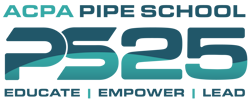
- This event has passed.
Improving the Design Life Cycle of Sewer Structures
March 8, 2023 @ 9:00 am - 10:00 am CST

Speaker: Kayla Hanson – Concrete Sealants
Presentation Description:
The term “corrosion” is typically associated with rusting steel or maybe even old batteries. However, other materials besides metals are also capable of corrosion. In the right conditions, a phenomenon called microbial induced corrosion of concrete (MICC) can degrade concrete structures and severely impact their structural integrity and service life.
MICC is a biogenic process of concrete degradation that is observed most in wastewater structures. MICC degradation occurs above the waterline and is evidenced by rough, pock-marked, and pitted concrete, and in more severe cases by diminishing and crumbling concrete paste that exposes reinforcement and leaves behind loose aggregates.
Specific environmental conditions must be met for MICC to occur, including progressing through a well-defined three-phase chain of events. Some wastewater systems may never progress through the necessary chain of events for this to occur while others will be prone to extreme MICC unless proper preventative and protective measures are taken, yet other systems may experience MICC in some structures but not in others.
MICC is heavily researched and well-understood. MICC prevention and treatment is not one-size-fits-all; each severity level is unique and requires a solution specific to the characteristics of the system. Fortunately, the wastewater industry is equipped with proven, research-backed solutions that are readily available to protect wastewater infrastructure investments against the costly and damaging effects of MICC.
During this one-hour session, we will discuss what microbial induced corrosion of concrete (MICC) is and how to identify whether a structure or system is experiencing – or might be prone to – MICC. Next, we will investigate the unique three-phase chain of events that must occur before MICC can begin. We will also discuss the specific roles that hydrogen sulfide gas, thiobacillus bacteria, and concrete pH play in preventing – or encouraging – MICC. Finally, using accelerated testing models, we will show predictive life cycles based on site conditions.
Learning Objectives:
1. Explain what microbial induced corrosion of concrete (MICC) is and how to tell whether a structure or system is experiencing MICC.
2. Describe the three-phase chain of events that must occur before MICC can take place.
3. Explain the roles that hydrogen sulfide gas, thiobacillus bacteria, and concrete pH play in preventing – or promoting – MICC.
4. Describe the life cycle prediction models and explain how this impacts the design life of sewer infrastructure components.
Upon conclusion of this session, participants will be awarded a certificate of completion showing one hour of professional development.
Speaker Bio:
Kayla provides technical consultation and product implementation assistance to customers, engineers, and end-users of all ConSeal products; she works closely with state DOTs and municipalities; and she serves as a liaison to the specifying community.
Kayla graduated from Purdue University in 2013 with a B.S. in Civil Engineering and an emphasis in structures. Kayla is a licensed Professional Engineer in Indiana. Prior to joining Concrete Sealants, Kayla worked for the National Precast Concrete Association for over eight years where she most recently served as the Director of Technical Services. During her time with NPCA, Kayla worked with various product-specific committees, conducted Plant Evaluations at precast concrete manufacturing plants, developed industry technical publications, and presented educational sessions at conferences and universities across the country.
Kayla’s primary areas of interest include durability and watertightness of precast concrete structures; water and wastewater storage, treatment, and conveyance infrastructure; transportation infrastructure; and resilience. Kayla is also involved in industry codes and standards groups including ACI and ASTM, and has served in various roles including the Secretary and Vice Chairman of ASTM Committee C27 on Precast Concrete Products.


